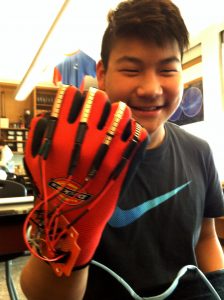For my money, the best use of technology in the S/M classroom brings students closer to actively building solutions to real world problems.
Here’s an example of the role tech plays in my combined Science/Math 9 class: for a year end project, a group of students elected to make a robotic hand that can be controlled with a second “flex glove”. The use-case would be to do toxic chemical handling or other dangerous work remotely.

They researched their topic online with school laptops, and collaboratively made planning documents with Google Sheets and Docs. A bit of math for budgeting and sourcing their parts, and then it was time to break out the Arduino boards for a hardware development. Borrowing heavily from the online coding community of knowledge, they constructed the circuit and flex glove. They ran into some problems making the servo motors match the motion of the fingers—algebra to the rescue! Adding multipliers to their code they calibrated the fingers to make it work.
Then comes the 3D printing, and on and on. They are having a blast, learning a ton, and in true constructivist fashion, they have an artifact that they can share with their peers and the community at large. I feel that the connection they make between their abstract coding and the very concrete movement of a hand are a perfect fit for that age and stage. If there is a misconception about coding, degrees of rotation, or the like, it will be obvious in short order. This tackling of the gap between formal and informal learning was the subject of my last post and is my latest favourite thing.
I don’t believe this level of tech is viable for all schools. We happen to have external sponsorship for this project and without it, the state levels of funding would be inadequate. Scaling up would require a major investment in infrastructure, tech support, and pro-D. Given that state funding is 3/5 of what it was 15 years ago. How do we collectively make this a priority? What low-cost tech options exist in the meantime?